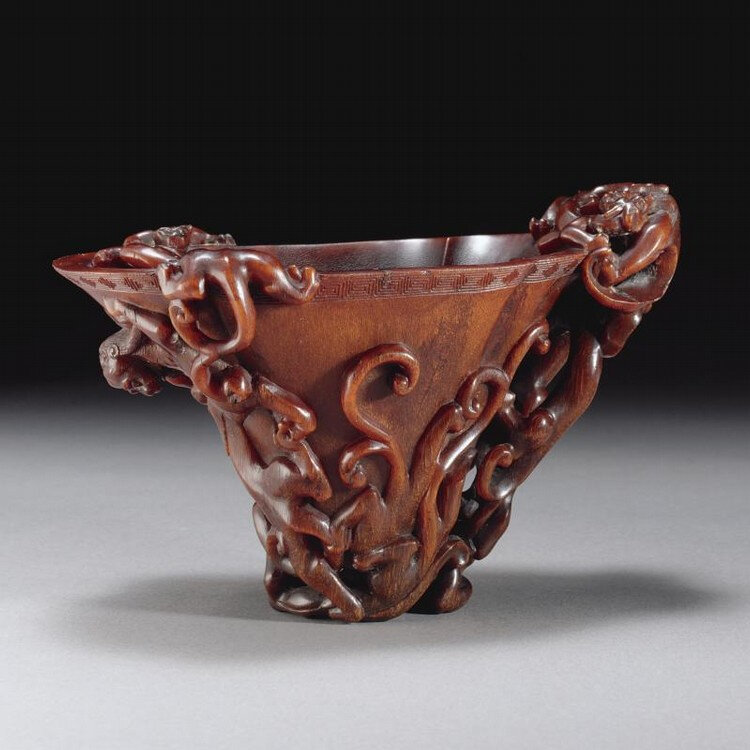A magnificent Imperial rhinoceros horn 'nine dragon' libation cup, Qing dynasty, Kangxi period
Lot377. A magnificent Imperial rhinoceros horn 'nine dragon' libation cup, Qing dynasty, Kangxi period (1662-1722); 7 3/8 in., 18.6 cm. Estimate 150,000 — 250,000 USD. Lot sold 180,000 USD. Photo: Sotheby's.
the very large horn displaying a superb polish and generous proportions, the dark amber-brown material lightening towards the rim to a glossy honey-russet tone, carved in an outstanding fashion with a flared quatrefoil-section libation cup tapering evenly towards a slightly inset base, and incised with a keyfret border on the outer rim, spectacularly accented with nine qilong dragons writhing over the entire surface in pursuit of each other, with a cluster of three of their sinuous bodies and bifurcated tails forming the reticulated foot, the others seemingly clambering up towards the rim in order to escape the frenzy of entanglement, the leonine head of one projecting completely out of the horn at the front of the cup, just as two others emerge over the rim into the interior and dead-lock in a menacing stare, the elongated bodies of a further two, with ridged spines and scrolling manes, forming the handle of the cup on the opposite end as they reach up to bite the smallest beast perched precariously on the very edge of the mouthrim, zitan stand.
Provenance: Collection of Kenyon V. Painter, Cleveland, Ohio & Arusha, Tanzania, circa 1910s.
By descent to the present owners.
Note: The present 'nine dragons' cup was presumably made in the Imperial Palace Workshops (Zaobanchu) as a presentation to the Imperial court since the number nine was reserved specifically for the Emperor himself. Such a high-ranking commission obviously deserved careful selection of the best material and the best craftsmanship, and both are clearly evident on the present Kenyon Painter cup - the horn material is without veins nor color imperfections and the fibers are extremely dense, indeed near the reticulated foot (which would have been nearer the tip of the horn) the polished horn is so dense as to resemble zitan. The workmanship is superlative, and while most other cups bearing clambering qilong have additional embellishments such as archaistic taotie bands, the present cup is left significantly plain, to better show off the material itself, and the virtuoso depiction of writhing energy. Indeed no other closely similar cup appears to be published.
Compare a series of cups with archaistic motifs accented with writhing qilong dragons, probably more securely in the Qianlong style, illustrated in Thomas Fok, Connoisseurship of Rhinoceros Horn Carving in China, Hong Kong, 1999, nos. 15, 19 & 20, and in particular a 'nine dragon' cup with scaly dragons instead, no. 12, now in the collection of the Hong Kong Museum of Art. One of the more spectacular 'nine dragon' cups with the classic scaly dragons is to be found, as expected, in the former Imperial collection now preserved in the Palace Museum, Beijing, illustrated in The Complete Collection of Treasures of the Palace Museum. Bamboo, Wood, Ivory, and Rhinoceros Horn Carvings, vol. 44, Hong Kong, 2002, no. 202, but appears more likely to be in the style of the Qianlong period, somewhat later than the present lot.
Sotheby's. Fine Chinese Ceramics and Works of Art, including Property from the Collection of the Albright-Knox Art Gallery, Buffalo, New York, 19-20 march 2007.

/https%3A%2F%2Fprofilepics.canalblog.com%2Fprofilepics%2F1%2F0%2F100183.jpg)
/https%3A%2F%2Fstorage.canalblog.com%2F03%2F02%2F119589%2F96711876_o.jpg)
/https%3A%2F%2Fstorage.canalblog.com%2F11%2F31%2F119589%2F94773502_o.jpg)
/https%3A%2F%2Fstorage.canalblog.com%2F20%2F83%2F119589%2F94772815_o.jpg)
/https%3A%2F%2Fstorage.canalblog.com%2F26%2F72%2F119589%2F75604929_o.jpg)
/https%3A%2F%2Fstorage.canalblog.com%2F59%2F60%2F119589%2F26458628_o.jpg)



/image%2F1371349%2F20240324%2Fob_e3ecaa_1.jpg)
/image%2F1371349%2F20240324%2Fob_ef0abf_1.jpg)
/image%2F1371349%2F20240324%2Fob_64049b_1.jpg)
/image%2F1371349%2F20240324%2Fob_a0994e_1.jpg)